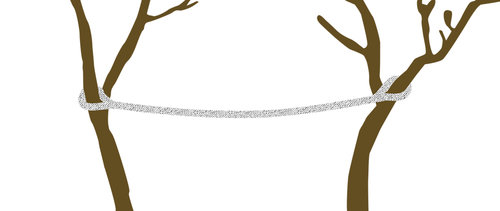Cabling is intended to offer additional support for trees with structural problems or poor architecture. For example, a tree with a tight “V” attachment may have codominant stems, which are more vulnerable to failure during extreme weather conditions, such as wind or ice load. Depending on the specific tree, one of two cabling options are available: Static or Dynamic cabling. Static cables consist of a steel cable that is attached between two stems by drilling into each stem. These cables minimize movement of the stems being supported and are used to provide support to very weak attachments or attachments that are already beginning to fail.
Dynamic cable is a woven, rope-like material that is spliced around the stems of the tree between the stems being supported. This type of cabling allows more natural movement between stems, while still providing support. In either case, more than one cable may be required for proper support. If you are concerned with the structural integrity of your tree, your Certified Arborist can help you decide if cabling is right for your tree, and which method is appropriate.
STATIC CABLING
Static cabling systems are mainly used to help provide supplemental support to tree parts in times of high load, such as storms. Some tree structures are more prone to failure than others. A tight “V” at the base of two stems is one such structure type. More than one cable is often needed to properly support the weight of the limbs.
DYNAMIC CABLING
Dynamic cable systems allow trees to continue natural stretch and movement in the weather. Once the limbs that have been cabled for attempted support move more than about 1-2 feet apart, the Dynamic Cable provides a link between the 2 stems so that they begin to balance their weight against each other.


